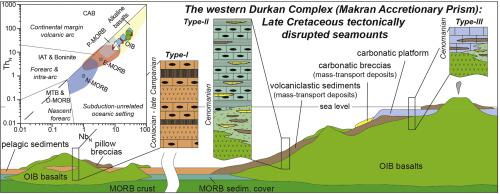Geoscience Frontiers ( IF 8.5 ) Pub Date : 2021-01-09 , DOI: 10.1016/j.gsf.2020.12.001 Edoardo Barbero , Luca Pandolfi , Morteza Delavari , Asghar Dolati , Emilio Saccani , Rita Catanzariti , Valeria Luciani , Marco Chiari , Michele Marroni

|
The Durkan Complex is a key tectonic element of the Makran accretionary prism (SE Iran) and it has been interpreted as representing a continental margin succession. We present here a multidisciplinary study of the western Durkan Complex, which is based on new geological, stratigraphic, biostratigraphic data, as well as geochemical data of the volcanic and meta-volcanic rocks forming this complex. Our data show that this complex consists of distinct tectonic slices showing both non-metamorphic and very low-grade metamorphic deformed successions. Stratigraphic and biostratigraphic data allow us to recognize three types of successions. Type-I is composed by a Coniacian – early Campanian pelagic succession with intercalation of pillow lavas and minor volcaniclastic rocks. Type-II succession includes a volcanic sequence passing to a volcano-sedimentary sequence with Cenomanian pelagic limestones, followed by a hemipelagic sequence. This succession is characterized by abundant mass-transport deposits. Type-III succession includes volcanic and volcano-sedimentary sequences, which are stratigraphically covered by a Cenomanian platform succession. The latter is locally followed by a hemipelagic sequence. The volcanic rocks in the different successions show alkaline geochemical affinity, suggesting an origin from an oceanic within-plate setting. Our new results indicate that the western Durkan Complex represents fragments of seamounts tectonically incorporated in the Makran accretionary wedge during the latest Late Cretaceous–Paleocene. We propose that incorporation of seamounts in the frontal prism caused a shortening of the whole convergent margin and possibly contributed to controlling the deformation style in the Makran Accretionary Wedge during Late Cretaceous–Paleocene times.
中文翻译:

西部的杜尔肯情结(伊朗东南部马克兰增生棱镜):晚白垩世构造断裂的海山链及其在控制变形样式中的作用
Durkan Complex是Makran增生棱镜(伊朗东南部)的关键构造要素,已被解释为代表大陆边缘演替。我们在此介绍西部Durkan联合体的多学科研究,该研究基于新的地质,地层,生物地层学数据以及形成该联合体的火山岩和准火山岩的地球化学数据。我们的数据表明,该复合体由不同的构造切片组成,既显示了非变质作用,又显示了非常低品位的变质变形演替。地层和生物地层数据使我们能够识别出三种类型的演替。I型是由一个科尼亚期的–坎帕尼亚早期的浮游演替构成的,中间夹有枕状熔岩和较小的火山碎屑岩。II型演替包括一个火山序列,该火山序列通过西诺曼底上层石灰岩传到火山沉积层序,然后是半海洋层序。这种演替的特征是大量的运输沉积物。III型演替包括火山和火山沉积序列,地层由一个Cenomanian平台演替覆盖。后者在局部之后是半海洋序列。不同演替过程中的火山岩显示出碱性的地球化学亲和力,表明其起源于大洋板内环境。我们的新结果表明,西部的杜尔肯复合体代表了在最近的白垩纪—古新世期间,在Makran增生楔中构造结合的海山碎片。











































 京公网安备 11010802027423号
京公网安备 11010802027423号